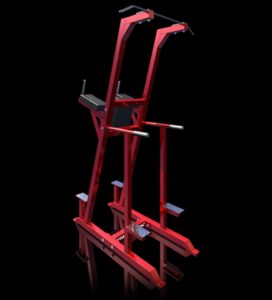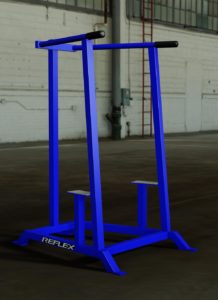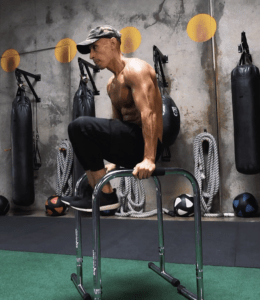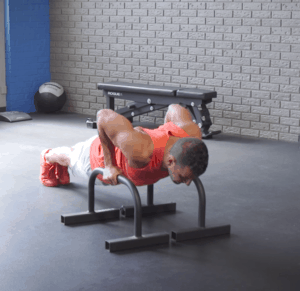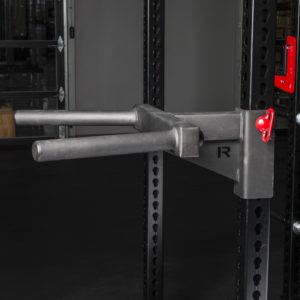We all love dips, being one of the best bodyweight chest exercises, and a portable dip bar (aka parallel bar) is quite a must for home gyms and apartments rooms alike that lack space.
Now before you say that you rather need a dedicated corner for a sturdier option like a Rogue dip station or Matador Dip Bar, you better know that these two were designed specifically for heavy use and weighted dips. Hence that’s where they excel.
However, you won’t be moving them around, and they don’t offer as much freedom in terms of versatility as a pair of portable dip bars, which also have a longer bar working area. Therefore if besides dips you like other bodyweight exercises as well (and you should), parallel bars are a rational investment and a must-have in your home gym arsenal.
I can’t stress enough, if your home gym only has so much room, versatility is key. And this is where portable dip bars shine, – or any kind of parallel bar really. It is a handy tool to build your chest, back, and bulletproof shoulders as well as abs through constant tension. This type of training is responsible for the dense muscles of gymnasts and people doing calisthenics.
A huge chunk of their exercises is based on using these parallel bars, being the bread and butter of their training, next to pull-up bars and gymnastic rings.
Though we need to clarify that portability, in this case, doesn’t mean you can travel around with your dip bar in your suitcase – leave this aspect to parallette bars (disambiguation later). Rather, you can freely move it around your house and more importantly, easily make width and angle adjustments best aligned with your body proportions such as shoulder width, body height, leg length.
In this post, I shed some light on what makes the best portable dip bars and how you can maximize their benefits.
Quick features and comparison review table of the best portable dip bars
| PRODUCT | FEATURES | HEIGHT | WEIGHT LIMIT | OUR RATING |
|---|---|---|---|---|
 |
RELIFE REBUILD YOUR LIFE Dip Station Stabilizer Parallette Push Up Stand
|
30.31-34.25 inch | 300LBS | |
 |
Lebert Fitness EQualizer Total Body Strengthener
|
28 & 31 inch | 400LBS | |
 |
Ultimate Body Press Dip Bar Fitness Station
|
30 inch | 350LBS | |
- Quick features and comparison review table of the best portable dip bars
- Portable Dip Bar Reviews
- Types of Dip Bars and Important Distinctions
- Benefits of Parallel Dip Bars
- Parallel Dip Bar Buying Guide for Home Workout
- What Muscles Can Be Worked With Parallel Dip Bars
- Best Parallel Bar Exercises
- Strength Prerequisites for Portable Dip Bar Home Workout
- Conclusion
Portable Dip Bar Reviews
RELIFE Dip Bar
Relife portable dip bars are height adjustable and offer the best all-around value for the functions for which these freestanding parallel dip bars are made for; that is to be lightweight but stiff enough to provide ample stability for bodyweight and calisthenics movements.
Lateral stability is ensured by a stabilizing safety connecting rod that can be inserted between the two crosslegs at the bottom. This prevents the accidental tilting of the rails especially common with beginners who lack shoulder stability.
There are 8 holes altogether on the connecting rod to fine-tune width adjustments that way the distance between the two handlebars’ can be set between 20-26.8 inches (or free to any distance without the connecting rod).
Relife parallel dip bars are made of durable heavy-duty steel that can support up to 300 pounds when used properly. Of course, a higher weight limit would always be better, except that in case of dip bars, it would come at the cost of portability. Leave weighted dips to dip stands and fixed dip stations.
The Relife has one not-so-common feature, which is the adjustability of the non-slip rubber end caps on the crosslegs. The cap’s opposing sides differ in thickness, so turning them individually to fit the ground, may prevent wobbling on uneven surfaces.
All in all, parallel dip bars don’t really need more than what the Relife dip station can offer, after all, it is just a pair of freestanding rails that you can move around and put away comfortably if not in use.
PROS
- Safety connecting rod for extra stability.
- Adjustable non-slip rubber end-caps can prevent shaking on uneven surfaces if screwed correctly.
- Stiff steel construction suitable for safe bodyweight training.
- Easy to store away, space-efficient.
- Easy to install, takes only a few minutes.
CONS
- Have to unscrew the crosslegs for height adjustability. Not sure why this technology is the norm with portable dip bars when the use of pull knobs are otherwise widespread across other types of fitness equipment.
Lebert Fitness Equalizer

The Lebert fitness portable dip stands are not height adjustable but you can get them in two different sizes. The basic, lower version is only 28″ tall which might be too low for some, but this way offers more stability, and more variety, depending on the exercise (few people even use it for Bulgarian split squats).
However, for taller-built users over 6 feet, I recommend the XL size that is 31″ high, which is pretty much the standard with portable dip bars anyway and allows for deeper dips and full rows.
Lebert Fitness dip bars are simply just two T-shaped rails, there’s no other useless fancy feature. They emphasize versatility first which comes from its truly freestanding nature. Place the bars separately in any way and at whatever angle you wish.
However, the advantage of its simplicity is its disadvantage as well. For a strict parallel use (as most dips are performed), an adjustable connecting rod would really come in handy, to provide more stability, especially for the XL version. This is not a useless feature, and I’m happy to see more and more manufacturers provide such solutions just like the Relife dip stand.
PROS
- Simple, truly free-standing solid T-shaped stainless steel structure.
- Available in two sizes, 28″ and 31″ height versions.
- Choose among many colors, even chrome.
- Portable, multi-purpose bodyweight strength equipment that’s easy to store away.
- 400 pounds weight limit.
- Besides the two dip bars, the package includes a resistance band, an exercise guide, and membership to an online fitness group.
CONS
- The smaller version might be too low for some exercises and for taller individuals.
- No height adjustment feature.
- The two bars can’t be connected together, this reduces stability or a secure feel.
Ultimate Body Press Dip Bar Fitness Station
The Ultimate Body Press Dip Bar is unusual in a way that the bent tubes once locked together, form one solid piece, as opposed to the 2 independent rails more common with portable dip bars.
This one-piece design structure is more rigid and creates more stability than free-standing parallel bars. On the contrary, it is less versatile. However, it completes the task at hand pretty well, which is dips.
So, when choosing between the T-shaped free-standing bar design and the Ultimate Body Press Dip Bar, you have to ask yourself;
do you need a training tool only for dips, or you wish to perform more complex moves as well like those of calisthenics training.
If so, you need more freedom, with regards to where you grip the bars, so the useful working area on the bar is something to consider. With UBP it’s pretty short, so you won’t do elbow dips aka Russian dips. Also, you need more freedom as to how and at what angle you position the bars to challenge other muscle groups, add variety. For example, what if you want to do rows with an overhand or underhand grip? Or perform bar dips which is a great step to progress for muscle-ups.
However, traditional dips it does well! And it would not be fair not to mention a few of its features that are admittedly nicely thought out:
PROS
- Collapsable design, it only takes 30 seconds to disassemble and be folded for easy storage.
- For easy assembly and adjustment, there’s a slight slack between the pieces, the parts fit loosely. No worries, it’s on purpose and as soon as you add your bodyweight the structure becomes rigid.
- The parts are color-coded for faster assembly.
- Compact design suited best for tiny apartments.
- Angled grips can be easier on your shoulders.
- Adjustable width at two levels 19″ and 24″.
- You can buy Ultimate Body Press accessories separately, a weighted dip belt, and an agility trainer for lower body. The dip kit includes an adjustable dip belt, 4 resistance bands with different strengths, quick-mount rings for easy anchoring, and a 10×14 inch workout poster.
CONS
- Pin and hole connections can be too loose and lack a secure feel.
- Apart from easy disassembly and storage, there’s no real benefit of this closed frame style dip bar over a pair of free-standing parallel dip bars.
- Short grip area.
Types of Dip Bars and Important Distinctions
There are so many types of home workout tools out there that it’s easy to get confused about different concepts. A dip bar can be anything from two branches to state-of-the-art dip machines.
There should be a logical separation because apart from the fact that obviously all of them can be used for dips, they all differ in terms of their usability and practicality.
Let’s clear the fog, and look at each of the most common concepts briefly from most to least bulky:
Dip Stations
These gym equipment are really on the heavy-duty side of home workout tools, therefore they were most prevalent in commercial gyms. Dip stations are versatile and rather big, but that’s where their pros lie, and in most of the cases, a pull-up chin-up bar and a backrest for leg raises are integrated into them; hence often called power towers.
Because of their enhanced versatility, dip stations can serve as a sole, multifaceted home gym equipment, much as Total Gyms can, with the main exception that TGs mostly use cables.
Dip Stands
Dip stands are a tad bit less bulky than dip stations. Because of their heavier weight, portability is still an issue, hence it’s best to create a permanent place for them.
They are mostly designed only for dips and feature a pair of parallel hand grips. Dip stands feature exceptional stability therefore excellent for heavy, weighted dips with dip belts, however for the same reason are the least versatile of all the dip bar types and most of them are not adjustable in any way.
Dip Bars That are Easily Portable, called Parallel Bars
The main subject of this article is parallel dip bars, but not the ones found on calisthenics playgrounds rather those that are a free-standing pair of bars thus easily portable.
These dip bars are the most versatile of all the other types, predominantly because of their separate, free-standing nature. They are the big brothers of parallettes, with greater height.
With increased height, comes greater flexibility in terms of usability. Typically parallel dip bars can be used for bodyweight dips, bodyweight rows, front levers, back levers, partial skin the cats. Basically, everything that parallettes can’t be used for because of their smaller size.
Parallettes
Parallettes have the smallest size of all, and while they can’t really be used for traditional dips (except for the shorter parallette dips), they are very useful for building all-around bodyweight strength and a ton of core strength; no surprise that parallettes are widely used among gymnasts.
You can fit the smaller ones even in your suitcase. They are such simple exercise tools, that you could easily make one on your own of cheap wood from the closest home depot.
You can best use parallettes for pushups for L-sit holds, handstands, V-sits, planches, L-sit to handstands and for various supports. Not like you could not do them with a parallel portable dip bar, it’s just that a parallette’s shorter height makes it extra difficult to tuck your legs to clear the floor for most support exercises.
Dip Handles
And finally, there are dip handles. Just like the Rogue Matador, they are rather just attachments to poles of power racks and they don’t offer much besides dips on their own, but that they do very well! The angled bars let you set the best position for your shoulders. Attached to a squat or power rack these dip handles become very powerful tools and can make a complete home gym, beating traditional dip stations every time.
Benefits of Parallel Dip Bars
Versatility
A pair of parallel dip bars can be moved around easily, they weigh around 20lbs the most, so it’s portability and consequently adjustability that gives their edge. Place a portable dip bar in any way, at any angle you like, that best fits your home workout. Once you are finished, put them to the corner, under the bed, or screw the legs off to win even more space.
Besides gymnastic rings and pull up bars, a pair of portable dip bars are the best investment for your home workout, especially if you like bodyweight training. You literally only need a couple of square meters in your apartment, should it be your living room, bedroom, or terrace to make great use of this ridiculously simple home gym equipment.
Within that tiny space, you can build upper body strength and tremendous functional core strength with constant tension and isometric training methods characteristics of parallel bar training. That freedom and functionality are unmatched by any other complex home gym equipment, total gyms, and complex cable machines even if high quality.
The only drawback is that parallel bars being bodyweight equipment, their usage requires a certain level of strength prerequisites to be used safely in the long term.
Superior Muscle Involvement, Easy on the Joints
Among many, one particular characteristic calisthenics training, parallel bar training, and gymnastics have in common is that they all heavily involve so-called closed kinetic chain movements (CKC).
These types of movements are more joint-friendly, presenting less shear force to the joints, and also spread the load across multiple joints, hence said to be more functional. They also promote right joint alignment through bone support since there’s no open end of the movement chain as opposed to open chain movements.
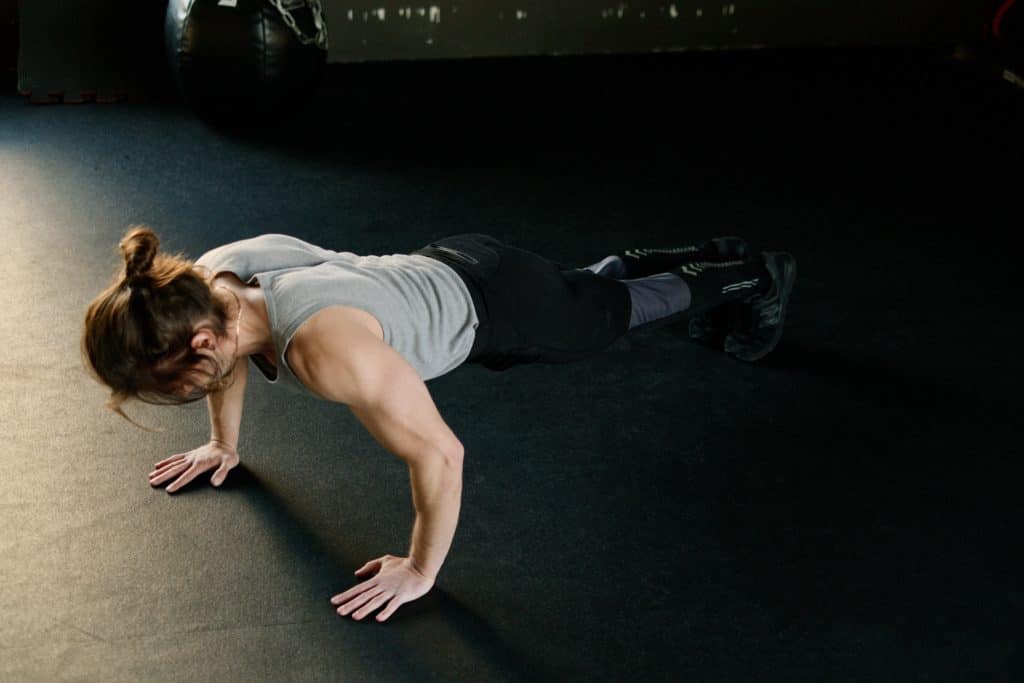
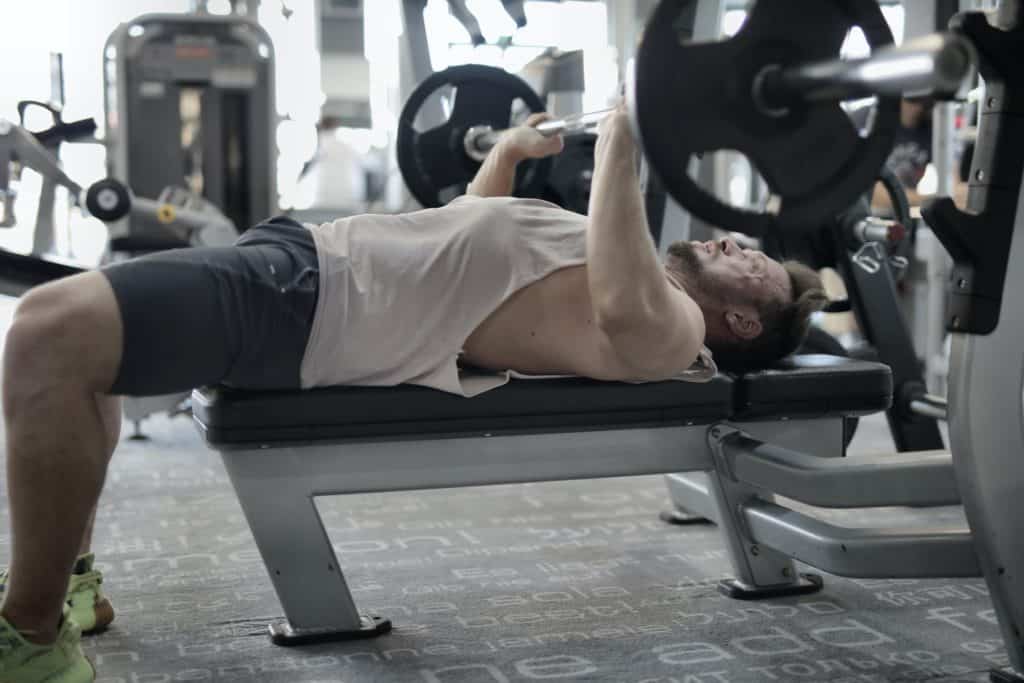
To better understand, the most often used example for an open-chain exercise would be the bench press, while a closed chain exercise would be a pushup. With the former comes one end “open” that is the hands holding the barbell can move freely.
In contrast, with closed chain pushups, both ends (hands and feet) are anchored to the ground making less room for error in general (forcing every joint to “their place” since there are no loose ends). Hence a better option for beginners, which by no means suggests that advanced or pro athletes wouldn’t benefit from it.
Moving your whole bodyweight is always a hard task when it is limited mainly to the upper body as is the case with most parallel bar workouts. The disadvantageous positions and angles make these bodyweight workouts very intense and for that reason recruit lots of muscle fibers, while still being joint-friendly since no external weight is added.
Increased Strength
Just like pull-ups, dips are usually very hard for beginner and novice lifters. Being able to perform even just 1 proper dip repetition, requires that you are able to crank out 20+ pushups with flawless form, easily any time. I don’t even bother with dips until my clients prove to be ready with such a prerequisite.
However, with greater intensity comes greater gains, once you can do dips for reps, a whole new level will open up. According to male dip standards, based on 120,000+ lifts, if a 200-pound guy dips out 9 reps, that’s the equivalent of 1 rep with 55lbs added weight. Pretty cool huh!? This is how hard dips are.
As far as strength ratios go, typically lifters can dip 105% of what they can bench press, so in terms of getting strong with dips, the sky is the limit, but that’s out of the scope of portable dip bars.
Increased Coordination
Calisthenics training and parallel bars go hand in hand, and among the many benefits of this type of training, improved isometric strength and coordination stand out.
Later in the “dip bar exercises” section, you’ll see there are endless ways to progress simple exercises with a pair of parallel bars, by using speed, joint end ranges, and combining movements into flows.
Also, isometric holds, characteristic of dip bar training, give you more time to perceive how the exercise feels. That way you can recruit more or just relax different muscle groups, leading to more efficient execution which over the long term translates potentially into more volumes of work, essential to muscle hypertrophy.
Local Muscle Endurance
It doesn’t need too much explanation, the long isometric holds, and constant tension flows mean more time under tension, which causes more blood-flow restriction in the working muscles that equals more metabolic stress. Besides initiating great muscle-building processes, this also improves the body’s ability to stay longer above the lactate threshold level, typically where you feel your muscles burning.
Your body will adapt more to this state of being which translates into more anaerobic working capacity, which in the end causes your home workouts to be more effective. All of which without investing in heavy weights, or turning your apartment into a mess. This is where parallel dip bars shine.
Parallel Dip Bar Buying Guide for Home Workout
Bar Height
A proper height for any exercise where your body’s starting position is a hang would be one where your feet don’t touch the ground plus a few more inches. Most dip bars and pull-up stations aren’t designed this way though which can compromise form and thus the exercise-induced effect.
This is why I recommend that the higher your parallel dip bar is, the better, and look for one with adjustable features. Portable dip bar heights range typically between 28-35 inches.
With height come stability issues, so it’s important that when you pick an adjustable parallel bar you pay attention to how wide its base is. The wider the better.
Weight Limit
Portable dip bars aren’t designed for heavyweight use in general. Just because you have two freestanding bars with wide bases doesn’t mean you can put a whole lot of pressure on the bars, because it will at some point tilt to the sides.
It’s almost impossible to find parallel dip bars with a weight limit of less than 300 pounds, which is plenty for most lifters, so long they do bodyweight training. Even if they put on a weighted vest, it’s an easy task for most of the parallel bars, especially the ones subject to this review.
However, to stay safe it’s best that you avoid using heavy weights typically what dip belts were designed for. You do not even risk the possibility of exceeding the bar’s weight limit, but it’s most likely that the plates will hit the ground before you reach proper depth due to the low build frame of portable dip bars.
Width Between Bars
Obviously, this is only a concern of those parallel bars that are connected through a connector and allow for width adjustment. Just to get an idea, the width of FIG certified (Fédération Internationale de Gymnastique) gymnastics parallel bars can be adjusted from 42-52 inches, so this is the range that will be identical for most users.
Despite this, dips most often favor narrower setups, so typically dip bars can be adjusted anywhere between 20-40 inches.
Portable Dip Bar Stability
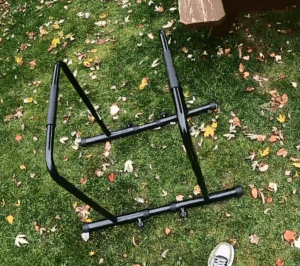
This is where a connecting rod comes in handy to prevent the possible tilting of the bars. However, this is a matter of usage.
In the case of dips, free-standing portable bars should provide enough stability by their wide base. Or the other way around, the user should only create a downward force against the dip handles and not lateral.
This is highly a matter of upper body strength and coordination. More specifically a function of pectoralis muscle strength. Normally, and ideally, you wouldn’t even need a stabilizing connector.
However, on uneven surfaces like grass, or in the case of calisthenics and its higher velocity and multiplanar moves, the safety connector proves to be very useful and since it can be removed easily it certainly doesn’t hurt to have this extra feature.
Materials and Grip
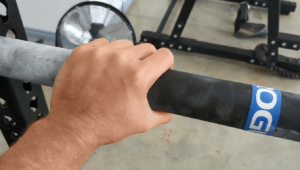
Most portable dip bars weigh around 15 to 20lbs and are made of 1,5mm thick steel tubes, which doesn’t sound like much, but still, plenty for bodyweight dips and calisthenics, with weight limits specified by manufacturers between 300-500 lbs.
Were these free-standing parallel bars any heavier and it would contradict the concept of portable and multi-purpose bodyweight strength equipment. The bars’ grip area is usually covered with a non-slip foam handle which creates a comfortable grip.
However, for some reason, powder coating, which is a common finish for parallettes isn’t used with parallel bars, at least I have yet to see any. It’s a pity because it’s light years better than a foam cover anyway.
So as long as glossy painted coverings are popular to cover steel, a foam grip is no doubt a must.
Portability and Storage
As mentioned in the intro, portability when it comes to parallel bars is restricted to easy mobility in your house as opposed to transportability. Unlike parallettes, you’re never going to squeeze a parallel bar in your traveling suitcase.
The mobility of portable dip bars lies in their lightweight construction and simple design which makes it easy to put them away. A major design flaw though is that, unlike other portable training tools, parallel bars are not foldable in an easy way. Usually, you have to unscrew the crosslegs to fit them into tight wardrobes or slide them under the bed.
Fixed or Adjustable Parallel Bar
Home workout tools need to be adjustable, period. The only exception is if you have so many workout equipments anyways and/or spacious rooms that you can afford to have a dedicated training tool for every exercise. Like a dip bar for dips, a pull-up bar for pull-ups, a squat rack that is only a squat rack, etc.
However, for the majority of us home workout seekers, who are not blessed with a luxurious garage gym, versatility is key to saving space and still getting an effective workout done.
So yes, if you can skip buying a dip bar or a dip stand because your parallel bar can be set a few inches higher due to an adjustable pull knob, Pbars are more than reasonable, since they can be used for horizontal rows, calisthenics, leg raises and so on.
Assembly
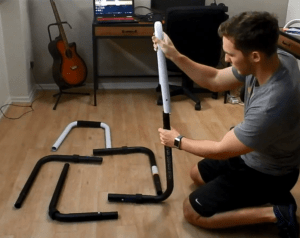
If you live in a very tiny apartment you might need to disassemble your parallel bar every now and then. This basically means for most Pbar dip bars that you need to unscrew the crosslegs. This doesn’t seem a hard task, but in the era of folding squat racks is still interesting.
Twistable crosslegs, or a foldable design would definitely be an improvement especially since parallel bars are so widespread as compact home gym equipment.
What Muscles Can Be Worked With Parallel Dip Bars
The main muscles worked the most during parallel bar dips are the pushing muscles of the upper body, namely the chest and triceps. Along comes, partly as stabilizers the front deltoid, lower trapezius, rhomboids, the back aka lats, and the rotator cuff.
It is believed that dips build a wider and thicker chest than bench press does. This is mainly because you can achieve a greater stretch in the chest muscle at the bottom of the movement which emphasizes the outer part of the pecs.
Also, dips force you to engage more muscles for stabilization and require more coordination since your body is not supported by a bench but you are to balance your whole body with your arms anchored. For this reason, as explained earlier, the dip is a closed chain exercise, meaning it activates multiple joints in a let’s say “more functional” way than the bench press does. Dips for example involve the core and serratus anterior muscle as stabilizers, with the latter muscle presenting great carryover to overhead presses.
Being more functional since you have to endure your whole bodyweight first, meaning before you attack the bench press, you need to be familiar with pushups, dips, pull-ups already. If you ever needed to climb over a fence or press yourself up from the side of a pool you’ll agree that it more mimics a dip as opposed to a horizontal push like a bench press.
Exerting a downward force in shoulder extension is more shoulder-friendly than lifting your arms up into shoulder flexion and pushing from there with your back supported. So dips and overhead presses are more fundamental than the bench press and although according to studies bench press variations represent a higher place in pectoral muscle activation and overall strength and muscle improvement, there’s a reason why dips are often called the upper body squat.
Now about what other muscles parallel bars can work in general, that is really up to the exercise itself. Calisthenics and gymnastics sports are both known for their wide range of exercises, and even more for their varieties. So for simplicity, let’s just highlight those muscles that are strengthened most often during classic parallel bar bodyweight training, typically consisting of dips, pushups, leg raises, and rows:
Worked much so
- Chest muscles
- Shoulders, rotator cuff, serratus anterior
- Triceps and biceps
- Lats
- Rhomboids and Trapezius, most often as stabilizers
- Core, abs, hip flexors
- Quads
Worked less so
- Spinal erectors to a less degree
- Glutes, hamstrings, calves
Obviously, this doesn’t mean that an L-sit to handstand or a back lever would not seriously work the entire back chain, so as the glutes and hamstrings. It just rather means you won’t see too many beginners tossing around such advanced feats.
Also, as you’ll see below in the exercise section, there are so many ways to come around the limitations of portable dip bars. Eventually, with a bit of creativity, even the less worked hamstrings and glutes can be trained, by doing Bulgarian split squats or hamstring bridges/hip thrusts with extended legs using the top of the dip bar as support.
Best Parallel Bar Exercises
In the video below you’ll see more of the classic use of a Lebert Equalizer Portable Dip Bar. The exercises covered are pretty much what most users will be using a parallel bar for and as you see these exercises are more than enough to elicit a great training effect with a home exercise tool as simple as a pair of rails.
In this video you’ll see basic exercises performed on a fixed parallel dip bar, just like the Ultimate Body Press.
Here are some more advanced dip bar exercises, whereas you’ll see the bar still holds pretty firmly, there’s no shaking or wobbling.
Finally here’s a 4-minute full-body dip bar home workout circuit if you are in the rush but still want gains. The majority of exercises are a staple for calisthenics and can be trained on a daily basis to strengthen the joints and connective tissues for more intense moves.
Strength Prerequisites for Portable Dip Bar Home Workout
Honestly, if you never worked out before and just starting out your home workout journey, before you rush on buying a pair of portable dip bars it’s best to stay humble.
Just to hold a dip position with your legs hanging right under your body, requires a good amount of body awareness and back strength to keep the shoulders in place.
Couple this by raising your legs forward to a dip L-sit hold and the above strength prerequisites become painfully real. You’ll need a good amount of lower trap function and strength in your lats to keep your shoulders down, and scapular retraction strength to prevent them from rounding forward. Let alone triceps and chest…
So in my opinion there are 5 strength prerequisites to fully reap the benefits of parallel dip bar training:
- 20 pushups unbroken.
- 3 solid pull-ups.
- 10 inverted rows with body parallel to the ground. High enough so the bar touches your abdomen each rep.
- 1 minute hanging from a bar to prove solid grip strength.
- Hollow body hold for 30 seconds, to prove core function and body awareness.
Conclusion
Few home gym equipment offers the degree of exercise variety and versatility that a parallel dip bar does. With this one lightweight tool, you can cover around 80% of the most popular bodyweight training in as little space as 4-6 square meters.
Portable dip bars are versatile on their own, they don’t need many fancy features or designs to be useful. They are best utilized and provide the most benefits when freely adjustable, hence I prefer the simple designed Relife and Lebert dip stands over other constructions.
Yet the main reason why the winner of this portable dip bar review is the Relife dip stand is that its simple rail design is reinforced with a stabilizer rod that can provide beginners with a secure feel and let them focus their attention on the exercise itself.
Remember, to maximize the benefits of your parallel bar workouts, try to train daily and put quality over quantity, and focus on time under tension training instead of blindly squeezing out rep after rep. In general dip bars and parallettes are best used and provide the most gains when high muscle tension is present, with high exercises demanding focused attention and great effort.
Parallel dip bar training is therefore a great addition to any home workout to counterbalance high-velocity interval training and low-intensity cardio bodyweight workouts.



